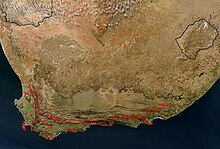| Protea cynaroides | |
|---|---|

| |
| Scientific classification | |
| Kingdom: | Plantae |
| Clade: | Tracheophytes |
| Clade: | Angiosperms |
| Clade: | Eudicots |
| Order: | Proteales |
| Family: | Proteaceae |
| Genus: | Protea |
| Species: | P. cynaroides
|
| Binomial name | |
| Protea cynaroides (L.) L.
| |

| |
| IUCN range
Extant (resident)
| |

| |
| Synonyms[2] | |
| |
Protea cynaroides, also called the king protea (from Afrikaans: koningsprotea, Xhosa: isiQwane sobukumkani[3]), is a flowering plant. It is a distinctive member of Protea, having the largest flower head in the genus. The species is also known as giant protea, honeypot or king sugar bush. It is widely distributed in the southwestern and southern parts of South Africa in the fynbos region.
The king protea is the national flower[4] of South Africa. It also is the flagship of the Protea Atlas Project, run by the South African National Botanical Institute.
The king protea has several colour forms and horticulturists have recognized 81 garden varieties, some of which have injudiciously been planted in its natural range. In some varieties the pink of the flower and red borders of leaves are replaced by a creamy yellow. This unusual flower has a long vase life in flower arrangements, and makes for an excellent dried flower.
Protea cynaroides is adapted to survive wildfires by its thick underground stem, which contains many dormant buds; these will produce the new growth after the fire.
- ^ Rebelo, A.G.; Mtshali, H.; von Staden, L. (2020). "Protea cynaroides". IUCN Red List of Threatened Species. 2020: e.T113204772A157948114. doi:10.2305/IUCN.UK.2020-3.RLTS.T113204772A157948114.en. Retrieved 18 November 2021.
- ^ "Protea cynaroides L." Plants of the World Online. Royal Botanic Gardens, Kew. Retrieved 28 July 2023.
- ^ Potgieter, Liezl, ed. (2019). "king protea". The Agricultural Trilingual Dictionary. Western Cape Department of Agriculture. p. 88. ISBN 978-0-9947024-2-5.
- ^ "About government - National flower". South African Government Information. Government Communications (GCIS). 28 November 2007. Archived from the original on 26 September 2011. Retrieved 14 October 2011.
